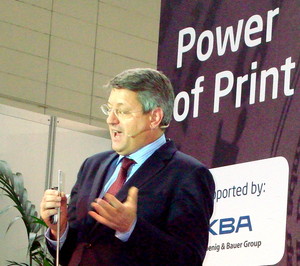Fortunately, there are plenty of strategies and tactics available to them, as became apparent at the Power of Print Session: Selling print capacity at World Publishing Expo 2012 in Frankfurt.
Some particularly promising measures originate from outside our industry. In his presentation, entitled “What newspaper printers can learn from the brand-name products industry,” Kurt Kribitz, Managing Director, Styria Print Group, Austria, described how he draws on his experience in the packaging industry, during which he worked closely with makers of brand-name articles.
During his presentation, it became apparent that the application of structured business thinking can open up entirely new perspectives for printing houses.
The problem, said Kribitz, can be defined as the emergence of a “strategic gap” between the revenue earned from printing newspapers and the revenue needed to continue earning a reasonable return on investment. In Styria’s case, printing other standard coldset products would not have been sufficient to close the gap, so something else was required.
Following standard business analysis, four possible strategies for opening up new revenue streams were considered:
- increasing penetration in existing markets,
- development of new markets,
- development of new products, and
- diversification into entirely new business areas (introducing new products into new markets).
Styria decided to implement the first three strategies, but not the fourth.
Differentiation the key factor
Increasing penetration in existing markets meant intensified efforts to find new customers, primarily in Austria. The key factor was differentiation – making sure Styria had something unique to offer that brought value to the customer. In fact, the term “unique selling proposition (USP)” occurs several times during Kribitz’s presentation.
Training of salespeople took on new importance, as did knowledge about potential customers.
Increasing market penetration is the easiest way to increase capacity utilization, but it carries the risk of drawing an overwhelming number of inquiries, which can be very time-consuming to process. More significantly, it can push prices down. Kribitz stressed that simply undercutting competitors’ prices is a dead-end street, and said a rule was drawn up: “Never fall below a pre-defined price threshold.”
Developing new markets for existing products is more complicated and riskier, but has more potential for business expansion and for bringing new knowledge into the organization. For Styria, it means going outside Austria and Croatia (it already is the dominant player in Croatia and number two in Austria) to Italy and Germany. These are some of the factors that can produce success in new markets:
- language skills,
- marketing skills,
- product skills,
- advisory skills,
- sales skills,
- know-how about the target customers, and
- good preparation before market entry.
Risks of expanding internationally include currency exchange-rate fluctuations, greater likelihood of non-payment of invoices, higher levels of investment required in new organizational structures, and possible neglect of the core market.
Deep knowledge about the customer’s business
The company’s rule for new markets is this: The salesperson is to contact a customer only after creating a value proposition for him or her. That implies that the salesperson is well-trained and has deep knowledge about the customer’s business – two points that Kribitz stressed several times in his presentation.
Finally, launching new products in existing markets has its own set of success factors, including innovation skills, a budget for research and development, and a business plan. A significant advantage of an innovative new product is that price is not the main focus during negotiations with ad customers.
By the company’s rule, a new product must have clear, noticeable value and a story that can be told simply.
Fifty-six ideas for new products emerged from a two-day workshop for Styria staff members, said Kribitz. Of those, one has been brought to fruition: a wrapper around the printed newspaper. It has opened the door to advertisers who otherwise do not use newspapers: makers of cosmetics and brand-name articles. The unusual combination of impact and topicality has made the wrapper an “important weapon” on the ad market, Kribitz said.




